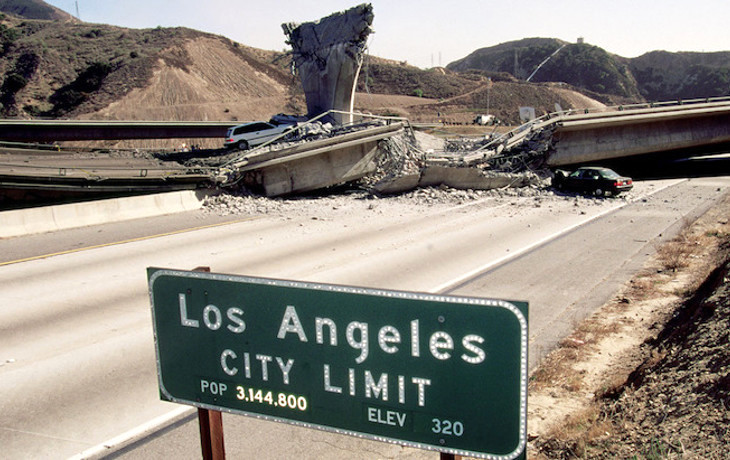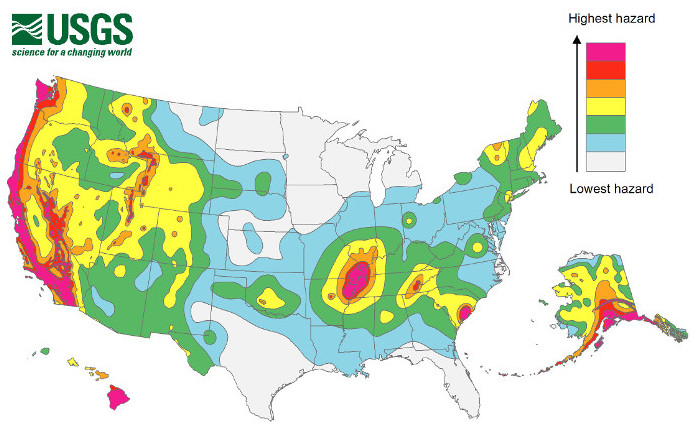What would you do if there an earthquake
What would you do if there an earthquake
I use the first type of conditional.
What will you do if.
1 an earthquake occurs? – If an earthquake occurs, I will leave the building quickly and quietly.
2 a fire alarm goes off?- If a fire alarm goes off, I will go through the nearest emergency exit.
3 there’s a blackout?- If there`s a blackout, I will wait at home or go to bed.
4 you see a car crash?- If I see a car crash, I will call the police and go away from the car.
| torch |
| whistle axe life-jackel compass |
| torch |
| whistle axe life-jackel compass |
4.Decide which object you would use if:
b) the boat you were on started sinking. – life-jacket
torch whistle axe life-jacket compass
1 5 How’ could these accidents have been avoided?
3 The town was flooded. The dam burst. – If the dam didn`t burst, the town wouldn`t have been flooded.
4 Two cars collided on the road. One of the drivers had been drinking. – If one of the drivers hadn`t been drinking, two cars wouldn`t have collided on the road.
5 A cyclist was seriously injured by a car at night. The cyclist had no lights on his bicycle.- If the cyclist had had lights on his bicycle, he wouldn`t been injured by a car at night.
6 A garage exploded. A man threw his cigar out of the window of his car.- If the man hadn`t thrown his cigar out of the window of his car, a garage wouldn`t has (have) exploded.
6 Go through the sentences and note how the form of the verb changes with “unless”. Then, rewrite the sentences.
1 If you don’t have a map, you will lose your way.
. Unless you have a map. you will lose your way.
2 If we don’t transmit a message now, it will be too late.- Unless we transmit a message now, it will be too late.
3 If the windscreen isn’t clear, how can the driver see?- Unless the windscreen is clear, how can the driver see?
4 If you don’t wear warm clothes, you’ll get cold. – Unless you wear warm clothes, you`ll get cold.
5 If we don’t refill our air tanks, we’ll suffocate. – Unless we refill our air tanks, we`ll suffocate.
Fill in the correct tense then identify the type of conditional.
1 If we lived in a well-built house, we wouldn`t be (not/be) in danger.-
2 The car will not roll (not/roll) back as long as you put the brake on.
3 You might cut yourself if you played (play) with knives.
4 I would always wear a helmet if I were (be) you.
5 If you’d locked the medicine up. He wouldn`t have drunk (not/drink). it.
6 Supposing you got (get) stuck in the lift, what will you do?
7 If he had listened (listen) to the weather forecast, he
wouldn’t have sailed in such stormy weather.
8 What would you do (you/do) if there was an emer-
9 If you hear the alarm, will head for (head for) the exit.
10 If he had been driving more carefully, he would have avoided (avoid)
Rewrite the sentences using inversion.
1 If someone tries to break in. call the police.
2 If I were you, I’d hire a bodyguard.- Should I were you, I`d hire a bodyguard.
3 If he had let off flares, they would have spotted him.- Would he has let off flares, they spotted him.
4 If you see smoke, activate the alarm.- Would you see smoke, activate the alarm.
5 If she hadn’t gone through the traffic lights, she wouldn’t have hit the pedestrian.- Would she has gone through the traffic lights, she hadn`t hit the pedestrian.
Table of Contents
Our partners
This publication was produced by Public Safety Canada in collaboration with:
The Canadian Red Cross, Natural Resources Canada, and the St. John Ambulance.
Please note: Publications are not available in regular print format.
© Her Majesty the Queen in Right of Canada 2011
Cat. No.: PS48-9/2-1-2011E
ISBN: 978-1-100-17948-3
Introduction
Approximately 5,000 earthquakes are recorded in Canada each year, most of them small ones.Whileearthquakes can occur in any Canadian region, British Columbia is most at risk from a major earthquake. Other areas prone to earthquakes are the St. Lawrence and Ottawa River valleys, as well as parts of the three northern territories.
In the past 100 years, at least nine earthquakes in or near Canada have registered a magnitude greater than 7. A few have caused extensive damage. Even a magnitude 6 earthquake could do extensive damage in a built-up area. In fact, a strong quake near one of Canada’s major urban areas would likely be the most destructive natural disaster this country could experience.
Everyone has a responsibility to protect their homes and their families. Since no one can predict with certainty when an earthquake will happen, it is important to get prepared in advance. This involves three basic steps:
Planning for an earthquake will also help prepare you for many other types of emergencies. After reading this guide, keep it in a handy spot, such as in your emergency kit.
What to expect during an earthquake
Small or moderate earthquakes
Large earthquakes
Step 1: Know the Risks and Get Prepared
To get prepared for an earthquake, you should know the risks specific to your community and your region to help you better prepare. To find out what the hazards are in your region, visit the ‘Know the risks’ section of the GetPrepared.ca website.
Before an Earthquake
Go through your home, imagining what could happen to each part of it, if shaken by a violent earthquake. Check off the items that you have completed in this list.
During an earthquake
Wherever you are when an earthquake starts, take cover immediately. Move a few steps to a nearby safe place if need be. Stay there until the shaking stops.
If you are indoors: “DROP, COVER AND HOLD ON”
If you are outdoors
If you are in a vehicle
AVOID the following in an earthquake
After an earthquake
Step 2: Make a plan
Every Canadian household needs an emergency plan. It will help you and your family to know what to do in case of an emergency. Remember, your family may not be together when an earthquake or other emergency occurs.
Start by discussing what could happen and what you should do at home, at school or at work if an earthquake strikes. To be prepared, make a list of what needs to be done ahead of time. Store important family documents, such as birth certificates, passports, wills, financial documents, insurance polities, etc. in waterproof container(s). Identify an appropriate out-of-town contact that can act as a central point of contact in an emergency.
Write down and exercise your plan with the entire family at least once a year. Make sure everybody has a copy and keeps it close at hand.
For more information on making an emergency plan, call 1-800-O-Canada or visit GetPrepared.ca to download or complete an emergency plan online.
Step 3: Get an emergency kit
In an emergency you will need some basic supplies. You may need to get by without power or tap water. Be prepared to be self-sufficient for at least 72 hours.
You may have some of the items already, such as a flashlight, battery-operated radio, food and water. The key is to make sure they are organized and easy to find. Would you be able to find your flashlight in the dark?
Make sure your kit is easy to carry. Keep it in a backpack, duffel bag or suitcase with wheels, in an easy-to-reach, accessible place, such as your front hall closet. Make sure everyone in the household knows where the emergency kit is.
Basic emergency kit
You can purchase a pre-packaged emergency kit from the Canadian Red Cross at www.redcross.ca. Visit GetPrepared.ca or call 1-800-O-Canada for a list of additional emergency kit items, including a car emergency kit.
Resources
National Resources
For more emergency preparedness information, visit GetPrepared.ca or follow @Get_Prepared on Twitter.
Provincial And Territorial Resources
For regional or local information on emergency preparedness, contact your emergency management organization as follows:
Alberta
Alberta Emergency Management Agency
Telephone: (780) 422-9000 / Toll-free: 310-0000
aema@gov.ab.ca
Manitoba
Manitoba Emergency Measures Organization
Telephone: (204) 945-3050 / Toll-free: 1-888-267-8298
www.manitobaemo.ca
New Brunswick
New Brunswick Emergency Measures Organization
Telephone: (506) 453-2133 / Toll-free 24 Hour line: 1-800-561-4034
https://www2.gnb.ca/content/gnb/en/departments/emo.html
Newfoundland and Labrador
How to prepare for and survive earthquakes
Earthquakes are a matter of when, not if. The U.S. Geological Survey says 143 million Americans live in areas where damaging earthquakes can occur. Yet the majority of people are unprepared because of complacency, denial, or ignorance — the recipe for becoming a victim. We’ve spent over 30 hours — on top of years of experience as emergency preparedness instructors — putting this one-page guide together so you won’t be helpless.
It’s hard to believe, but it’s true: earthquakes affect all 50 states. The worst scenarios threaten primarily the West Coast, which has tectonically feuded with faults and plates for eons. But other spots like Oklahoma, Nevada, Wyoming, St. Louis, Memphis, Charleston, and Anchorage are in the danger zone, too.
Seismologists and emergency management leaders are growing increasingly worried, and speaking out more publicly, about the risk of long-overdue “Big Ones” — the nasty quakes on the scale of magnitude 7.0 to 9.9 that will devastate millions of people.
Earthquakes are tough because we don’t see them coming a week in advance the way we can track a hurricane’s menacing, colorful swirl on a Doppler radar.
Despite advances in seismology and technology, we can’t yet predict earthquakes. Even though sensors and alert systems are getting better, they might give you only 5-30 seconds of warning.
Don’t rely on strange animal behavior to alert you, either.
Part of The Prepared’s Sane Prepper Rules is accepting that you can’t predict what will happen or where you’ll be. You can’t assume the roads will be fine. Or that you’ll have time to run to the grocery store or fill the bathtub or have electricity and running water.
We talked with Chris Ipsen, an emergency management coordinator with the City of Los Angeles. He said plainly, “People need to plan for the worst case scenario. Plan on not getting anywhere. You need to be self sustained.”
The goods news is that with some simple preparation, such as getting your home ready for two weeks of self-supported survival, you drastically increase your chances of comfortable survival.
Why you should trust us
We spent 31 hours researching earthquake preparation for this post. This includes FEMA, state, and local guidelines for communities from Seattle to San Diego, and lessons learned from severe quakes here and abroad.
We interviewed emergency management officials, including from hot spots like Los Angeles. In addition, some of the authors have lived and taught prepping skills in San Francisco, Seattle, Oakland, and Los Angeles.
Earthquake survival kit checklist
Whether you are worried about earthquakes, hurricanes, or fascist alien zombies, every good prep has 80% or more of the same foundation. For example, having two weeks of water in your home is a great idea for a very wide range of possible emergencies.
Our prepping 101 checklist focuses on three goals:
If you’re on a tight budget or don’t know where to start, follow our beginner’s guide. It will help you prioritize things like water and suggests exactly the gear you can buy today.
The rest of this guide focuses on gear and knowledge specific to earthquakes above and beyond that basic foundation.
How to prepare your home for earthquakes
Reduce dangerous things that will fall during an earthquake
One of the easiest steps you can take this weekend is to secure things that will fall.
Let gravity be your interior design guide. Don’t hang items over your bed. Secure pictures and frames. Bolt shelves to walls. Put heavier objects on lower shelves. Install latches on your cabinets so you’re not dodging dinner plate shrapnel.
Take annual videos of your possessions
It’s always a good idea to take a simple video of the things you own. As part of your annual prep review, take 20 minutes and walk around your house with your cellphone camera rolling. Point out anything valuable that you would want replaced.
Even if you don’t have insurance that would cover an earthquake, sometimes there are extra government or non-profit relief programs that step in to fill the gap. Having your records in order can shave months off the process.
Earthquake insurance
Homeowners or renters insurance usually doesn’t cover earthquake damage. Earthquake coverage is a separate product, much like flood insurance.
California is the only state that mandates insurance companies offer earthquake coverage to people who buy residential policies. Purchasing it is voluntary. For Californians, we recommend checking out a public-private program, the California Earthquake Authority, which offers policies with deductibles of 5% to 25%. But the actual coverage is underwritten by your individual insurance outfit. The premiums are based on the reconstruction value of your home, not the appraised value. No other state has a similar program.
Statewide, only about 10% of Californians enroll in earthquake coverage. To the north, about 19% of Oregonians, and between 12-15% of Washingtonians are earthquake-insured.
Not all earthquake insurance is the same, so take the time to understand what a policy covers.
Fracking-related quakes are considered to be caused by humans, for example. In places like Oklahoma, there’s been tension about what qualifies as “natural earthquake” damage in a claim.
For renters, buy supplemental earthquake coverage. Don’t expect your landlord’s or property owner’s insurance to cover you.
Retrofit your home to survive the earthquake
There’s a range of retrofits you can make to older buildings that make a huge difference between total collapse and just a few bumps and bruises. In short, the more a home is “tied together” from foundation to roof, the more likely it will survive.
Countries like Japan and Chile have done an excellent job developing and enforcing earthquake construction codes. Beyond saving lives, strict building code also saves tons of money in the long run.
Although states and cities have varying levels of codes, in general, America has struggled to even study how many buildings are at risk of collapse. The head of the Washington National Guard, Maj. Gen. Bret Daugherty, recently told Northwest Public Radio, “I think we should start sooner, and I’m very concerned about the unreinforced masonry buildings that we have.”
Unreinforced masonry buildings, which are brick, stone, or adobe structures, can crumble to a pile. For these brick homes, retrofits often mean tying the walls to the floor and roof, adding a steel frame, and bolting the wall to it.
If your home was built before 1974, it’s possible your home isn’t built to withstand earthquakes at all. The Uniform Building Code (now the International Building Code), which an international brain-trust of engineers updates every few years, is the basic construction blueprint enforced by many states and cities. The code first specified seismic design criteria in 1973.
Wood homes tend to fare better than concrete or brick because wood has some natural flexibility. But even pre-1970s stick built homes typically aren’t secured to the foundations.
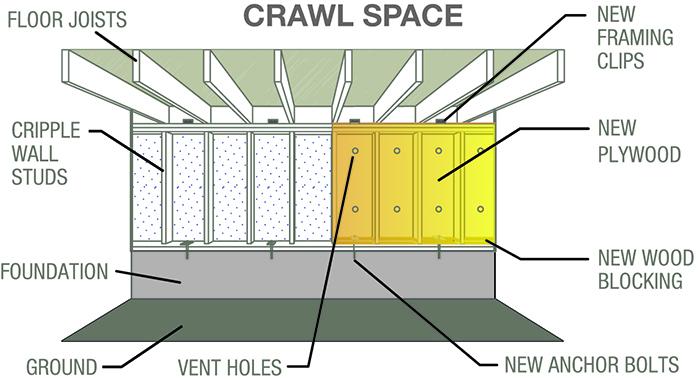
The most common retrofits for making homes earthquake-ready are:
There are programs and grants that might help you cover retrofit costs.
In California, the Earthquake Brace & Bolt program offers grants to qualifying homeowners based on a lottery system to help pay for retrofits.
Cities along the West Coast have some form of mandates or standards for retrofits. For example, Santa Monica, California, passed in 2017 the country’s most extensive retrofit plan to include concrete tilt up, soft story, steel moment frame, non-ductile concrete, and unreinforced masonry. It’s more inclusive than the ordinance of its neighbor, Los Angeles. However, retrofits are voluntary for homeowners in Oregon and Washington.
Be ready to shut off your gas or install an auto-shutoff valve
Fires are one of the biggest risks after a quake. Be sure you know where your gas valve is and how to turn it off.
Find a wrench that you know works with your valve and keep it in your nearby emergency supplies. That way you can manually shut off the gas after a quake. Be aware that a utility guy or gal will have to turn it back on.
If you smell gas or hear a leak, shut off your gas (unless you have an auto-shutoff valve). Quakes often cause gas leaks, which lead to fires.
Typical example of where you would shut off your gas:
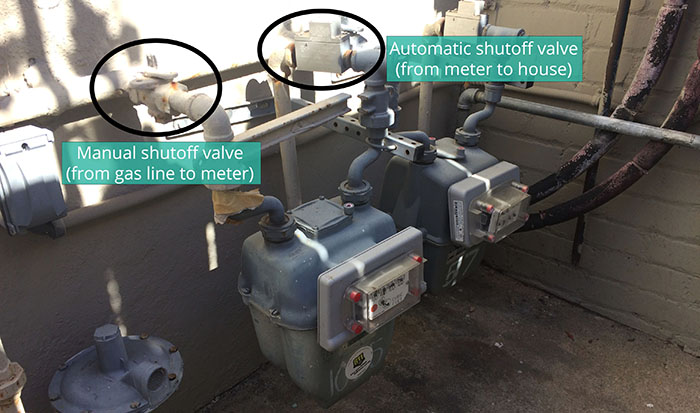
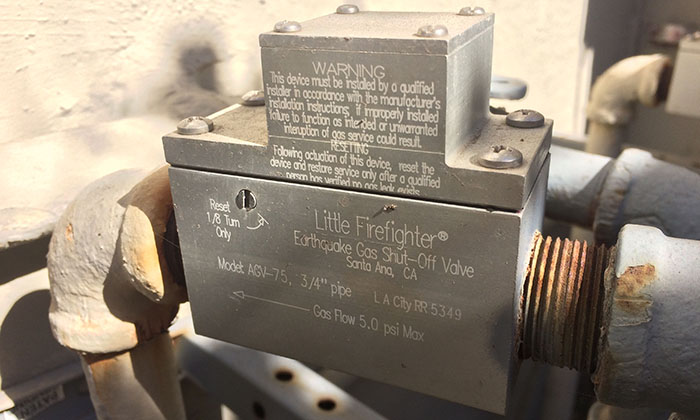
With an adjustable wrench, give the manual valve a good turn. It’s on the input side of the meter, coming out of the ground.
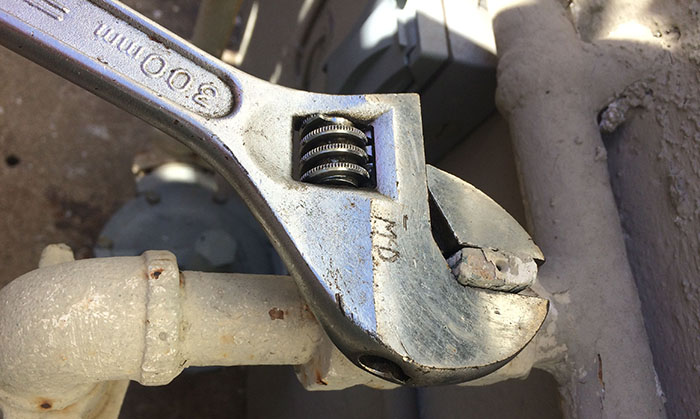
Storing your supplies
Assuming you’ve built up your basic emergency preparedness supplies, are there any special considerations about storing supplies for earthquakes?
Remember the biggest issue with earthquakes is the shaking and falling. So try to put your supplies in the safest, lowest place possible that is still easily accessible. There’s also no point in putting supplies on the floor if there’s a shelf full of heavy stuff above that will fall and crush them.
For example, store supplies on the floor of your garage underneath a sturdy and secured workbench. If you’re in an apartment, use the floor of a closet that’s closest to your exit door.
Like any good prep, keep your supplies properly stored. That means potable water should be in dark, food-grade plastic — see our review of the best water containers for preppers. Supplies should be easy to move, so keep them in portable, sturdy bins or backpacks.
A good Bug Out Bag should be quick and easy to grab and go at a moment’s notice. That’s especially true for earthquakes. Try storing your bag and a good pair of shoes as close to the exit door as possible.
Since it’s a good idea to have multiple flashlights in the house, keep some with your core supplies, but keep others scattered around the house. A bedside nightstand is perfect.
What you should do during an earthquake
Some places in the world are developing, or have, warning systems. ShakeAlert in California, for example, might give you a 10-60 second warning through your phone.
In most cases, an earthquake will surprise you with a jolt. There is essentially no time to do anything other than get to the best, closest place to survive.
The most important thing in any emergency scenario: don’t panic! Having a clear head is one of the biggest factors between people who survive and those who don’t. That’s easier said than done, since it’s not everyday the whole world shakes around you.
To practice, once in awhile just imagine that things suddenly start shaking. Visualize it. What would you do if it happened right now?
Things falling is the largest killer during an earthquake.
No matter where you are, that’s the thinking you should burn into your brain. Things are falling. Get cover.
Take a look at these clips from the 6.9 magnitude 1989 Loma Prieta earthquake in California:
Notice how quickly the overhead lights start falling on top of the students? That’s why the most fundamental earthquake advice is to drop and cover.
Clips from the 2011 Japanese 9.1 magnitude quake — notice the large debris falling on people running out of their office building at 0:30:
They’re sitting by an open door at street level. The first shakes hit quickly, and they immediately run outside. But we can’t tell what’s above them, and you can actually see electrical sparks flying from the transformers shaking loose above their head.
Or this 2016 magnitude 7.8 earthquake in New Zealand:
Even though this was relatively mild (especially for a 7.8) and it didn’t even knock the pictures off the wall, their mistake was waiting too long to get cover. The first 40 seconds are relatively mild. We’re not suggesting you start screaming, but you shouldn’t sit there waiting for things to get worse. Thankfully, they do the right thing and get under their desks once things got serious.
We don’t believe in long checklists you’ll never remember in the moment. But here’s the official advice based on where you are:
If you’re in bed:
There’s a shelter-in-place tactic called the “Triangle of Life,” which suggests getting yourself near a sturdy object, like a cabinet. The idea is you can survive in the void created by the floor, a sturdy object, and a piece of ceiling or wall that falls.
It’s wrong. Don’t do it. It might work in other countries where buildings pancake collapse because their building codes aren’t robust, but not in the U.S.
What you should do after an earthquake
You’re just as likely to die in the time after an earthquake as you are during one. Fires, tsunamis, disabled utilities, impassable roads, injuries, and overwhelmed emergency services make for a bad scenario.
As soon as the shaking has stopped:
Aftershocks
“People don’t really understand or realize how damaging aftershocks can be,” said Ipsen. “They could go on for weeks. I was here for Northridge, and some of the aftershocks were actually worse than the initial quake.”
Aftershocks differ from earthquakes only in that we expect them.
Aftershocks can happen for weeks, months, or years. In general, the larger the initial quake (called the mainshock), the larger and more numerous the aftershocks, and the longer they will continue, according to the U.S. Geological Survey.
Omori’s modified Law is one theory that attempts to make sense of aftershocks. They are common immediately after the mainshock and decay in time with roughly the reciprocal of time since the mainshock. So, the second day has about 1/2 the number of aftershocks of the first day. The fifth day has about 1/5 the number of the first day, and so on.
Tsunamis
Underwater earthquakes can cause massive amounts of energy, which in turn creates tsunamis. You likely saw how much devastation the tsunami caused following the 2011 Japan earthquake:
For those in tsunami zones, particularly Washington, Oregon, California, Hawaii, and Alaska, getting to higher ground should be top priority. So grab your Bug Out Bag or Get Home Bag and get high — ideally on natural elevation instead of a building roof.
Find your tsunami zone:
If you are near water and you see that water moving backwards towards the open ocean: run!
As a tsunami approaches, it sucks away the water in front of it to support the big waves. There are countless videos of people walking out onto the beach, Instagramming the weird views of water retreating away from them as they walk on the coral. They usually die.
Here’s a video from the 2004 Thailand Tsunami:
Shelter-in-place vs. grab your Bug Out Bag and go
Think of staying in your home as the default choice. Most survival experts agree that it’s usually best to stay in your home.
You should only choose to leave home if there’s a good, calm-headed reason to do so. Maybe the structure is unsafe, there’s fire, and so on.
That’s a big part of why preparing to survive in your home for two weeks, without any outside help or utilities, is one of the basics of prepping. You would rather stay in place than have to trek on foot for 5-20 miles, through dangerous conditions, just to get drinking water.
Earthquake insurance usually covers the costs of a hotel or other shelter.
What things might be like after the quake
In 2016 the U.S. Navy, Coast Guard, and Washington state’s National Guard did a full-scale, nine-day drill to test how well they could respond to a massive earthquake in the Cascadia Subduction Zone. That area covers Vancouver, Seattle, and Portland through northern California.
The 83-page report comes to a lot of scary conclusions. The authors admit the systems are not ready, infrastructure would collapse, and they’d have a full-blown humanitarian crisis in ten days.
Robert Ezelle, director of the Washington Emergency Management Division, put it simply: “There is an urgent need for residents to prepare for two weeks.”
On the ground
Everything has been torn and shaken. That means electrical lines and equipment might’ve fallen, creating sparks on the ground. Water lines might be broken and flooding. Ruptured gas lines might continually feed fires.
Roads and bridges might be destroyed. Sinkholes may have opened.
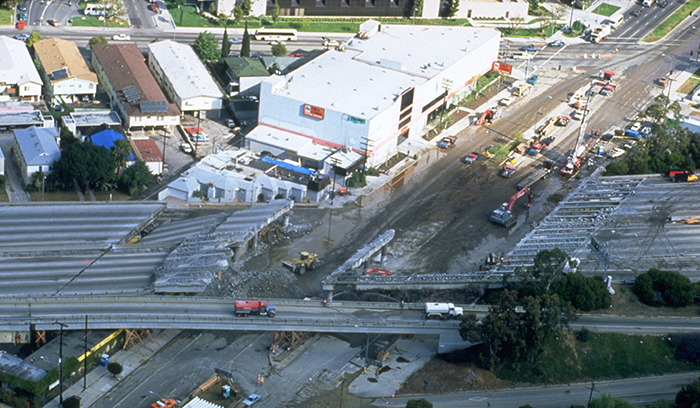
Communication networks are likely down or overloaded. You might not get solid information for a while. Radio is the reliable bet — check out our intro guide to Ham radio for prepping.
Expect emergency services to be overwhelmed. They simply aren’t meant to handle large disasters with hundreds of thousands or millions of people suddenly needing help.
You or others might be injured, or worse. If so, expect a sense of disoriented panic and people crying for help.
Long term recovery
Especially in a Big One scenario, government’s own reporting suggests that things will take a long time to get back to normal.
Here’s an example. The Oregon Resilience Plan, which reads like a Hollywood disaster movie script, provides these infrastructure restoration estimates under current conditions:
| Critical service | Valley (roughly I-5 corridor) | Coast |
|---|---|---|
| Electricity | 1-3 months | 3-6 months |
| Drinking water & sewer | 1 month-1 year | 1-3 years |
| Schools | 18 months | 18 months |
| Police and fire | 2-4 months | 3 years |
| Healthcare facilities | 18 months | 3 years |
| Major highways | 6-12 months | 1-3 years |
| Telecommunications | 6-12 months | 6-12 months |
| Liquid fuel | Extremely vulnerable | Extremely vulnerable |
Source: Oregon Seismic Safety Policy Advisory Commission
For a common bad-but-not-devastating earthquake, look to Chile and Japan, two nations that have recently endured seismic beatings.
After the 2010 magnitude 8.8 Maule Earthquake in Chile, the country restored 90% of communication and 95% power supply within two weeks. Flights resumed after 10 days.
After the 2011 magnitude 9.0 Tohoku Earthquake, Japan restored more than 90% power supply in ten days, 90% of telephone lines in two weeks, and 90% of cellular base stations in 19 days.
Insurance claims and relief programs
As soon as you’re able, begin the process of filing earthquake insurance claims, getting utilities restored, and recovering important documents.
If you’re properly prepared ahead of time, you can get the ball rolling on this quickly and efficiently. Because most other people won’t have the right records, you can slingshot to the front and in some cases get your relief payments months before other victims.
Sources and footnotes:
Chris Ipsen, emergency preparedness coordinator, City of Los Angeles. Interview by phone. Oct 2017.
Trent Sanders, retired Los Angeles County sheriff’s deputy. Interview by phone. Oct 2017.
The Really Big One. The New Yorker. Jul 2015.
Unreinforced Masonry Buildings. Seattle Department of Construction & Inspections. Oct 2017.
Residential Seismic Strengthening. City of Portland, Oregon, Bureau of Development Services. Jun 2016.
Seven Steps to Earthquake Safety. Earthquake Country Alliance. Oct 2017.
The 1933 Long Beach Earthquake. State of California, Dept. of Conservation. Oct 2017.
What Are the Odds of Dying From…. National Safety Council. Oct 2017.
The Oregon Resilience Plan. Oregon Seismic Safety Policy Advisory Commission. Feb 2013.
Earthquakes Guide. Occupational Safety and Health Administration. Oct 2017.
A Summary of Requirements in the State of Oregon. State of Oregon, Building Codes Division. Feb 2012.
Natural Gas Safety. Associated of Bay Area Governments, Resilience Program. Oct 2017.
Aftershocks: The What, Where, and When. Kentucky Division of Emergency Management. Oct 2011.
The California Earthquake Preparedness Survey Facts. UCLA School of Public Health, California Emergency Management Agency. Mar 2010.
What would you do if there an earthquake
Report this sentence correctly.
‘I can swim really fast.’
He said that he could swim really fast.
Which words CANNOT go in the space?
We ____ have won the game if we’d played a little better.
can
would
Complete the question.
What would you do if there _____ an earthquake?
Complete this question.
Do you know how tall ____?
they are?
is it?
he’s?
Complete the sentence.
Alex ___ late. He’s stuck in traffic.
will be arrive
will arriving
will be arriving
will be arriving
Report this sentence correctly.
‘There was an accident outside the supermarket’.
He said there had been an accident outside the supermarket.
Complete the sentence.
If the weather ____ better, we could’ve gone to the beach.
Which sentence is NOT correct?
She’d go out more if she would have more free time.
If we lived in that house, we could get a dog.
If I were you, I’d discuss the situation with my boss.
She’d go out more if she would have more free time.
Which question is correct?
Can you tell me if where you were born?
Can you tell me where were you born?
Can you tell me where you were born?
Can you tell me where you were born?
Choose the correct answer:
By the end of this year. Then I’ll find a job.
I’ll have finished my diploma.
I’ll be finishing my diploma.
I am going to finish my diploma
I’ll have finished my diploma.
Tom said ‘I’m going to London tomorrow.’
Five days later you say.
Tom said he was going to London the following day.
Which sentence has the same meaning?
I lost Jennifer’s number so I couldn’t call her.
If I had lost Jennifer’s number, I could’ve called her.
If I hadn’t lost Jennifer’s number, I could’ve called her.
If I hadn’t lost Jennifer’s number, I couldn’t have called her.
If I hadn’t lost Jennifer’s number, I could’ve called her.
Complete the sentence.
If I had more money, I ______ that television.
How to Prepare for an Earthquake
Earthquakes happen without warning. We don’t know when the next major earthquake will happen, but we can take action now to prepare to survive it and minimize impact. Preparedness starts with a plan. For cities and agencies, this means working with engineers to retrofit older structures and design new buildings, bridges, and highways to withstand an earthquake as best as possible. For individuals and families, this means putting together an earthquake preparedness plan and kit and knowing what to do before, during, and after an earthquake.
Before: Are You Ready for a Rumble?
Earthquakes strike suddenly, violently, and without warning. Identifying potential hazards ahead of time and planning in advance can reduce the dangers of serious injury or loss of life from an earthquake. Repairing and reinforcing building foundations, anchoring overhead lighting fixtures to the ceiling, securing furniture and other objects to walls and floors, and following local seismic building standards will help reduce the impact of earthquakes.
Many injuries suffered during earthquakes result from items falling or shifting due to the shaking of the earth. Identifying potential hazards prior to an earthquake can protect you and your family. Do an inventory of your house and where you work. Anything that can move or fall during a quake should be placed in a closed cabinet or a secondary container. Anything that can’t be put elsewhere should be securely fastened down or, for objects such as bookcases, attached to the wall. Avoid hanging pictures or mirrors near beds or places where people sit.
After an earthquake, you might not have access to water, food, electricity, or other necessities for up to a week. Creating a disaster supply kit will help you get through the aftermath of an earthquake. Store enough water, food, and other basic items to meet your needs for at least 72 hours. Keep the kit in a place where you spend most of your time so that it will be easily accessible if an earthquake strikes.
It is also a good idea to develop an emergency communication plan. Do not rely on cell phones or other devices that require electricity. Develop a plan for reuniting after the disaster in case family members are separated from one another during an earthquake. Ask an out-of-state relative or friend to serve as the family contact. After a disaster, it’s often easier to call long distance than locally. Make sure everyone in the family knows the name, address and phone number of the contact person.
Six Ways to Plan Ahead
1. Check for Hazards in the Home
2. Identify Safe Places Indoors and Outdoors
3. Educate Yourself and Family Members
4. Have Disaster Supplies on Hand
5. Develop an Emergency Communication Plan
Make a plan for reuniting after the disaster in case family members are separated from one another during an earthquake (a real possibility during the day when adults are at work and children are at school).
6. Help Your Community Get Ready
Publish a special section in your local newspaper with emergency information on earthquakes. Localize the information by printing the phone numbers of local emergency services offices, the American Red Cross, and hospitals.
Conduct a week-long series on locating hazards in the home.
Work with local emergency services and American Red Cross officials to prepare special reports for people with mobility impairments on what to do during an earthquake.
Provide tips on conducting earthquake drills in the home.
Interview representatives of the gas, electric, and water companies about shutting off utilities.
